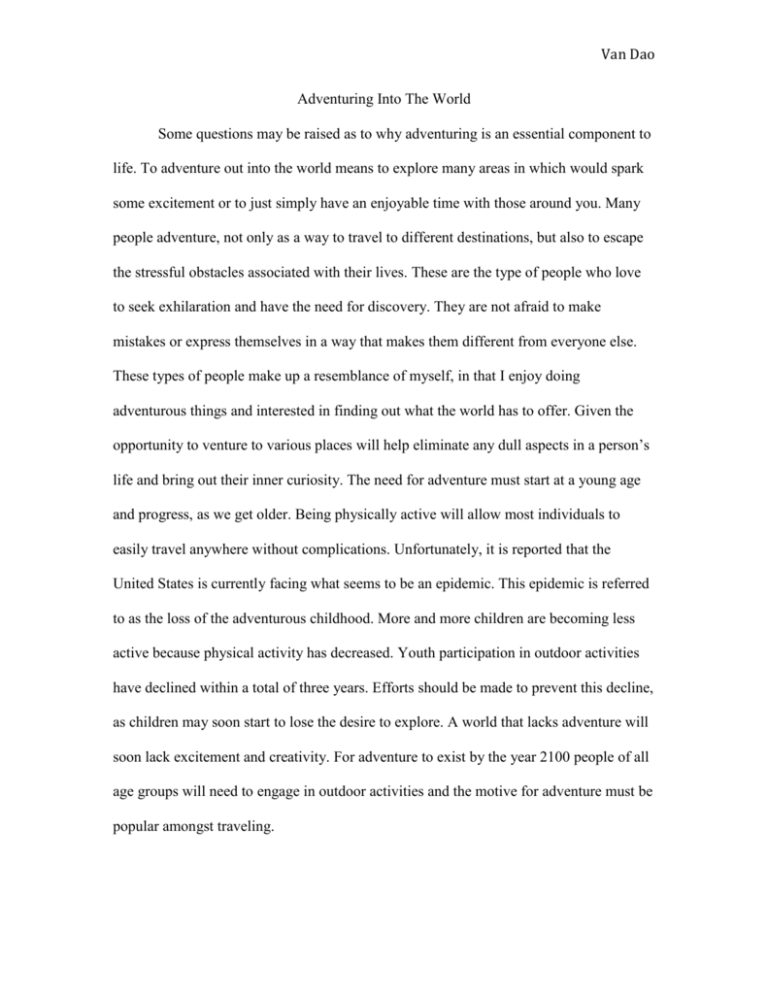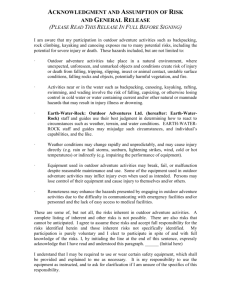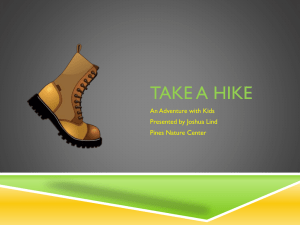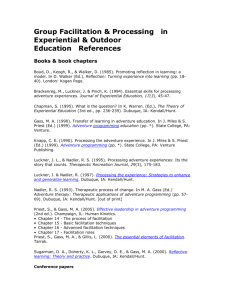Speculative Essay
advertisement

Van Dao Adventuring Into The World Some questions may be raised as to why adventuring is an essential component to life. To adventure out into the world means to explore many areas in which would spark some excitement or to just simply have an enjoyable time with those around you. Many people adventure, not only as a way to travel to different destinations, but also to escape the stressful obstacles associated with their lives. These are the type of people who love to seek exhilaration and have the need for discovery. They are not afraid to make mistakes or express themselves in a way that makes them different from everyone else. These types of people make up a resemblance of myself, in that I enjoy doing adventurous things and interested in finding out what the world has to offer. Given the opportunity to venture to various places will help eliminate any dull aspects in a person’s life and bring out their inner curiosity. The need for adventure must start at a young age and progress, as we get older. Being physically active will allow most individuals to easily travel anywhere without complications. Unfortunately, it is reported that the United States is currently facing what seems to be an epidemic. This epidemic is referred to as the loss of the adventurous childhood. More and more children are becoming less active because physical activity has decreased. Youth participation in outdoor activities have declined within a total of three years. Efforts should be made to prevent this decline, as children may soon start to lose the desire to explore. A world that lacks adventure will soon lack excitement and creativity. For adventure to exist by the year 2100 people of all age groups will need to engage in outdoor activities and the motive for adventure must be popular amongst traveling. Van Dao Prior to the goal in 2100, certain events must occur to accomplish this. Physical education must exceed beyond school education levels by the year 2025. As people continue to engage in physical activity, they are more likely to do the same throughout their life. According to statistical evidence, approximately half of American youth ages 12-21 are not engaging in vigorous outdoor activities on a daily basis. Around 14% of young people are not physically active at all. Individuals within the 12-year range age group have a 20-30% higher physical activity level than individuals within the ages of 20-21 years old. This means that people within higher age groups engage in less physical activity than those who are younger than them. Physical activity levels tend to decline, as the person gets older. With this in mind, there are steps in which could contribute to the improvement of physical activity amongst people of all age groups because it is essentially necessary to keep the mind and body at a good health condition. Physical education classes tend to end after high school; therefore, certain laws should be made to continue these classes after school education. People who continue to stay in shape on a daily basis will more than likely keep that activity level going regardless of their age. Nonetheless, if physical education classes were offered after a certain grade level, it would be possible to achieve the goal of having more physically active people by the time they reach the age of 21. However, this may take some time and there may be little progress since most people become busier as they reach adulthood. They may not be able to attend any physical classes due to the interference of their work or other responsibilities they must fulfill. With this being said, people who are physically active will most likely engage in more activities, thus potentially increasing their desire to adventure out in the world. This, in result, is one step closer to achieving the main goal. Van Dao By 2060, participation in vigorous events will increase. There are multiple outdoor related activities that people can participate in. These events can range from being effortless to requiring a great amount of physical work. Bicycling, with a participation rate of approximately 40 million Americans, seem to outrank most of the other outdoor recreational activities such as hunting, fishing, and bird watching. Following bicycling, the second most participated activity is hiking with around 35 million Americans participating. Camping, with a little over 30 million Americans, is the third most participated outdoor recreational activity. The activities with the most participation all share one thing in common. That is, they require a plethora more work than the rest of the activities displayed on that chart. Taking this under consideration, if this pattern continues then the likelihood for people to venture out to different places will increase because most activities requiring adventure include some type of vigorous activity. According to the statistics, lesser people participate in activities that do not require as much body movement. The reason behind that is not stated but it could be implied that more individuals would prefer doing activities that will keep them up and going. One exception to this would be that these trends are always changing and people may become less involved in vigorous activities as other activities may hinder their motivation to be physically active. In this current state where technology is advancing, many factors could exist to prevent people from going out. This increase in technology can cause more people to become less active and stay inside rather than being out and about. However, as more technological devices are made, people will be able to communicate more with their peers. They will be able to record and share their trips with Van Dao others through social media or in person. This in return will offer plenty of pleasant memories that can be relived over and over again. In order for adventure to be the most popular motive for traveling in the year 2100, people must be exposed to more places or become more involved in physical related activities. For that occurrence to happen rates of traveling must rise drastically and more attractions should be available for people to visit by 2075. There are plenty of different motives that can influence a person to travel from one place to another. These motives can be for psychogenic needs such as adventure, escapism, social interaction, or pure relaxation and destination attributes like for recreational activities or festivals. It is proven that roughly 80 percent of people travel to escape their daily routine. Around 65.6 percent do it for the nature aspects and 25.6 percent want to go to different places as a result of health and rejuvenation. Adventure, with only 12.8 percent of people, is not the top motivator out of the reasons for why people travel. However, adventure offers most of the aspects in which people want when they seek out to a different place such as an escape to their lives, nature, and health improvement. Other reasons besides adventure include religion and sporting events. Although adventure is not the top motivator for most people to travel, the trends could potentially rise as more people become aware of what adventuring can offer. This motive for traveling may not significantly rise to become the top motive because many people move from one place to another for more important reasons such as for business or family related problems. Adding onto this, money could interfere with how often people travel to different places. Someone may not be able to afford the transportation there, so traveling to closer places could be a possible way to avoid all the expenses that come with traveling. Van Dao Achieving the ultimate goal for 2100 will require much effort, but as all the events start to fall into place, there will be no doubt that in 2100 people will be engaged in vigorous outdoor activities regardless of their age and the need for adventures will be the reason why people travel. The growth of responsibilities as a person gets older could get in the way of their desire to explore and become active but if all age groups of people are required to attend classes of physical activity, a majority of them will maintain their activeness and proceed to do other events associated with vigorous activity. Another obstacle would be the rise in technology. For instance, advances in technology may cause a distraction for young children or even adults but with the use of improved devices, many are able to put them to use as they travel to different places. Recording down special moments and reliving the experience may increase their pursuit to explore newer places. Financial problems may arise due to the costs of transportation and equipment; however, making shorter trips or doing activities that do not have to involve spending money can conserve money. Furthermore, these situations pose as obstacles but will not prevent the goal of 2100 from happening. There will always be wonders to the world and breathtaking things to discover so it is important to keep this sense of adventure going for individuals regardless of how old they are. Van Dao References Andrews, Candice Gaukel. "10 Reasons Adventure Travel Is Good For You." Good Nature. Natural Habitat Adventures and WWF, 07 July 2015. Web. 04 Dec. 2015. "Greeks' Consumer Behavior in Tourism." Slideshare. Linkedin, 29 Aug. 2014. Web. 04 Dec. 2015. "Outdoor Rec Nature-Based Tourism." Slideshare. Linkedin, 20 Feb. 2013. Web. 04 Dec. 2015. "Physical Activity and Health." Centers for Disease Control and Prevention. Centers for Disease Control and Prevention, 17 Nov. 1999. Web. 04 Dec. 2015.







